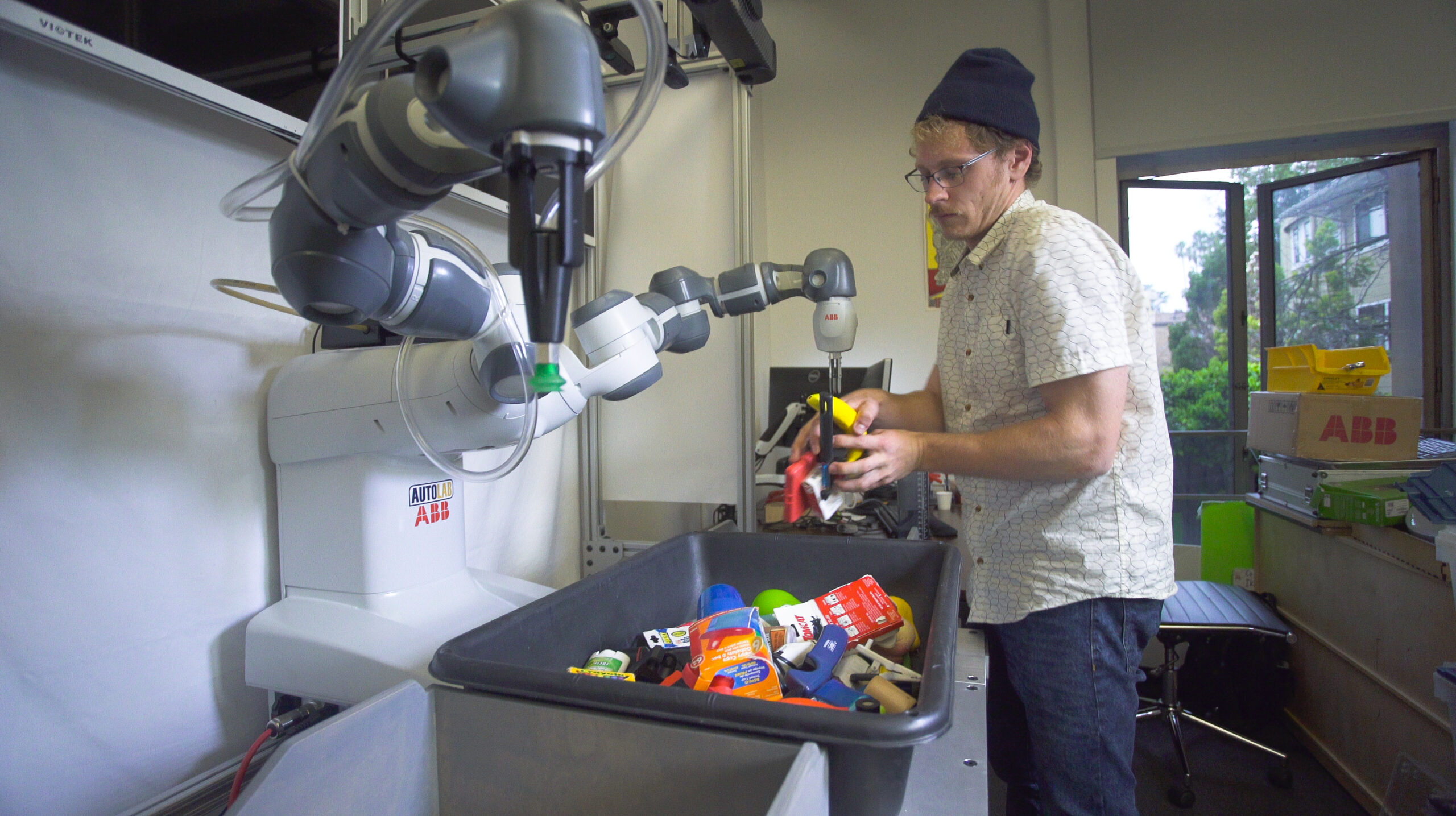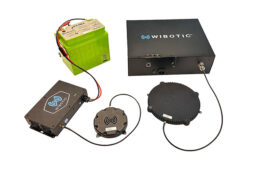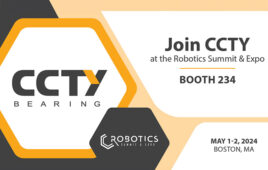Robotics concerns about the changing nature of work were just some of the many topics discussed in Day 2 of RoboBusiness 2018. Exhibitors demonstrated the latest in components and solutions, panelists gave advice on how to automate and measure ROI, and attendees networked.

SANTA CLARA, Calif. — Yesterday, the annual RoboBusiness conference continued and concluded here, as innovative startups, international investors, robotics suppliers, and prospective end users gathered to learn about how robotics concerns affect business.
After the big data workshop, numerous engineering sessions and robotics exhibits, and the popular Pitchfire startup competition, what more was there to discuss? Plenty, as it turned out. Here are some highlights from the second full day of RoboBusiness 2018.
Getting a grip with the fog
In his Day 2 opening keynote, Ken Goldberg, distinguished chair in engineering at UC Berkeley, described the “new wave” in robot grasping. “Grasping is a hard problem where demand is driven by e-commerce,” he said.

Prof. Ken Goldberg delivers a keynote at RoboBusiness 2018.
The first method involved programming robots with precise data of an object’s characteristics.
The second wave involved gathering real-world data and reinforcement learning, said Goldberg, citing Google’s “arm farm.”
“After one year and 10 million grasps, they got to a 20% failure rate, but that’s still high,” he said. “With good perception and control algorithms, you can have minimalist hardware, but you don’t want noisy data.”
The third wave is a hybrid, combining modeling and empirical data. Goldberg also explained how “fog robotics” distributes computing tasks among the cloud, the gateway layer, and edge devices.
Inspired by ImageNet’s 80 million images, Goldberg and his team have created Dex-Net, a curated repository of 3D models of a wide range of items. They have also launched Ambidextrous Laboratories, a startup to commercialize the technology.
How to implement robotics
Many of this year’s RoboBusiness 1,300 attendees were engineers, so one might expect a purely technical focus. However, sessions on robotics concerns around adoption and management were particularly well-attended. Also, RBR’s editors met representatives from major retailers, consumer products manufacturers, logistics providers, and integration firms in conference tracks and on the Expo Hall floor.
“First, ask, ‘Why automate?’” said Craig Salvalaggio, vice president of sales and engineering at Applied Manufacturing Technologies. He spoke during a two-part session on implementing an automation strategy and monitoring the results in the Chief Robotics Officer (CRO) Summit within RoboBusiness 2018.

AMT’s Craig Salvalaggio describes steps for successfully adopting automation at RoboBusiness 2018.
Bad reasons to automate include because someone saw cool robots at a trade show, chasing the competition that is automating, or rushing to buy because of a capital budget deadline, he noted.
“Clearly define your payback period, and map your current process flow,” Salvalaggio recommended.
“Robots are like computers in that they are easy to replicate, and like humans in that they are sensitive to different environments,” said Thavidu Ranatunga, chief technology officer at Fellow Robots, during a discussion about “Robotics Infrastructure at Global Scale.”
“Robots go through stages like humans — from baby, teenager, to adult — in terms of supervision,” he added. “But don’t expect good Internet, no matter where you are.”
Tessa Lau, CEO of Dusty Robotics, described her experiences from Savioke, which makes mobile robots for the hospitality and healthcare markets. The goal should be to go from having technicians on site, as Savioke did during testing, to monitoring them remotely during the “teenage phase,” and finally to entrusting operators with managing robots (depending on service-level agreements).
The challenges of scaling up production and management of robotics hardware also applies to software, noted Guillermo Manzato, partner at Ekumen Labs.
A theme that arose in several sessions was that executives should examine the entire value chain or production line before acting on robotics concerns.
Simulation can help enterprises model their factories or warehouses, said Daniel Theobald, chief innovation officer at Vecna Robotics. The use of simulation can help at the concept phase or the design phase, and it’s also important to model the behavior of humans in a process, he said.
Uncle Sam wants automation to succeed
Despite the lack of a centralized industrial policy in the U.S., several RoboBusiness speakers demonstrated that state and federal governments understand the importance of AI and robotics concerns to American economic competitiveness.

ARM Institute’s Suzy Teele moderated a panel on small manufacturers and robotics at RoboBusiness.
The panel on “Robots and Small and Midsize Manufacturers: Successes and Challenges” examined the sorts of questions the government wants to help automation newcomers to answer. One example was “What are the considerations for automating a process?”
“The top three considerations are if you have high volume and low mix, production issues requiring rework for throughput, and inline or end-of-line inspection needs,” said Raminder Sandhu, robotics practice lead at the California Manufacturing Technology Consulting (CMTC). CMTC is part of the Manufacturing Extension Partnerships (MEPs) across the U.S.
“Robotics should not be a ‘nice to have’ for a company; it has to be a ‘have to have,’ or something that can’t be done well another way,” said John Apgar, CEO at Owens Design. “Growth drives automation, not the other way around.”
Initial automation projects may fail because of a lack of realistic expectations, observed Joseph Maynard, special projects division department manager at window provider Walters & Wolf.
The Advanced Robotics for Manufacturing (ARM) Institute is dedicated as much to developing workforce training as it is to sharing technology innovations with small and midsize enterprises, said Suzy Teele, head of marketing and communications at the Pittsburgh-based public-private partnership.
Safety first
U.S. policies for worker safety need to be based on basic and applied research, explained Dawn Castillo, director of the Division of Safety Research at the National Institute for Occupational Safety and Health (NIOSH). NIOSH is part of the Centers for Disease Control and Prevention, and its Center for Occupational Robotics Research is working to collect safety data on collaborative robots and autonomous vehicles.
“We did research on traditional industrial robots back in the 1970s and ’80s, but we’re just getting started now,” said Castillo. She participated in the closing keynote on “Is Public Perception of AI and Robotics Changing?”
NIOSH publishes peer-reviewed papers and has a virtual reality laboratory for simulating interactions. It also has projects involving human subjects.
NIOSH has partnered with organizations including the Occupational Safety and Health Administration (OSHA), the Robotics Industry Association (RIA), and the ARM Institute to develop metrics around human-machine interaction. It has three projects to study safety data such as workers’ compensation claims, and it is looking to work with universities.
Jeremy Marvel, a computer scientist at the National Institute of Standards and Technology (NIST), echoed Castillo’s description of the federal government’s robotics concerns in his session on the “Risks and Rewards of Human-Robot Collaboration.”
Robotics concerns persist about ethics, jobs
In a keynote panel on the political implications of automation, Jonathan Krim, former technology editor at The Wall Street Journal, asked panelists about dire predictions of global job displacements. Brian Green, director of the technology ethics program at Santa Clara University, pointed to AI and robotics concerns about bias, privacy, cybersecurity, and “weaponized AI.”
By contrast, Rian Whitton, an analyst at ABI Research, said that widely publicized reports such as “The Future of Employment” study from the Oxford Martin School don’t match up with the fact that U.S. unemployment has fallen even as robotics adoption has risen.
“We don’t want to get complacent” about robotics concerns over safety, said Jeff Burnstein, president of the Association for Advancing Automation (A3, the parent organization of the RIA). He challenged his fellow panelists in the closing keynote to be positive in their approach to automation.
Robotics and AI are transforming industry, Burnstein said, and people can choose to build and use these tools for the good of society, such as in healthcare or search-and-rescue operations.
Editor’s note: More coverage of RoboBusiness 2018 to come, including video and presentation slides.
RoboBusiness will return to the Santa Clara Convention Center from Oct. 1 to 3, 2019.




